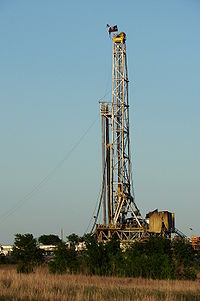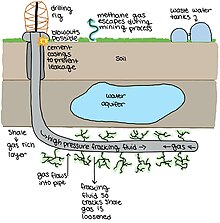
Back Fracking AN تصديع مائي Arabic Hidravlik parçalama üsulu Azerbaijani Хидравлично разбиване Bulgarian Fracturació hidràulica Catalan Hydraulické štěpení Czech Ffracio Welsh Hydraulisk frakturering Danish Hydraulic Fracturing German Hidraŭlika fendado Esperanto
 Fracking the Bakken Formation in North Dakota | |
| Process type | Mechanical |
|---|---|
| Industrial sector(s) | Mining |
| Main technologies or sub-processes | Fluid pressure |
| Product(s) | Natural gas, petroleum |
| Inventor | Floyd Farris, Joseph B. Clark (Stanolind Oil and Gas Corporation) |
| Year of invention | 1947 |
| Fracking |
|---|
 |
| By country |
| Environmental impact |
| Regulation |
| Technology |
| Politics |
Hydraulic fracturing[a] is a well stimulation technique involving the fracturing of formations in bedrock by a pressurized liquid. The process involves the high-pressure injection of "fracking fluid" (primarily water, containing sand or other proppants suspended with the aid of thickening agents) into a wellbore to create cracks in the deep rock formations through which natural gas, petroleum, and brine will flow more freely. When the hydraulic pressure is removed from the well, small grains of hydraulic fracturing proppants (either sand or aluminium oxide) hold the fractures open.[1]
Hydraulic fracturing began as an experiment in 1947,[2] and the first commercially successful application followed in 1949. As of 2012, 2.5 million "frac jobs" had been performed worldwide on oil and gas wells, over one million of those within the U.S.[3][4] Such treatment is generally necessary to achieve adequate flow rates in shale gas, tight gas, tight oil, and coal seam gas wells.[5] Some hydraulic fractures can form naturally in certain veins or dikes.[6] Drilling and hydraulic fracturing have made the United States a major crude oil exporter as of 2019,[7] but leakage of methane, a potent greenhouse gas, has dramatically increased.[8][9] Increased oil and gas production from the decade-long fracking boom has led to lower prices for consumers, with near-record lows of the share of household income going to energy expenditures.[10][11]
Hydraulic fracturing is highly controversial.[12] Its proponents highlight the economic benefits of more extensively accessible hydrocarbons (such as petroleum and natural gas),[13][14] the benefits of replacing coal with natural gas, which burns more cleanly and emits less carbon dioxide (CO2),[15][16] and the benefits of energy independence.[17] Opponents of fracking argue that these are outweighed by the environmental impacts, which include groundwater and surface water contamination,[18] noise and air pollution, the triggering of earthquakes, and the resulting hazards to public health and the environment.[19][20] Research has found adverse health effects in populations living near hydraulic fracturing sites,[21][22] including confirmation of chemical, physical, and psychosocial hazards such as pregnancy and birth outcomes, migraine headaches, chronic rhinosinusitis, severe fatigue, asthma exacerbations and psychological stress.[23] Adherence to regulation and safety procedures are required to avoid further negative impacts.[24]
The scale of methane leakage associated with hydraulic fracturing is uncertain, and there is some evidence that leakage may cancel out any greenhouse gas emissions benefit of natural gas relative to other fossil fuels.[25][26]

Increases in seismic activity following hydraulic fracturing along dormant or previously unknown faults are sometimes caused by the deep-injection disposal of hydraulic fracturing flowback (a byproduct of hydraulically fractured wells),[27] and produced formation brine (a byproduct of both fractured and non-fractured oil and gas wells).[28] For these reasons, hydraulic fracturing is under international scrutiny, restricted in some countries, and banned altogether in others.[29][30][31] The European Union is drafting regulations that would permit the controlled application of hydraulic fracturing.[32]
Cite error: There are <ref group=lower-alpha> tags or {{efn}} templates on this page, but the references will not show without a {{reflist|group=lower-alpha}} template or {{notelist}} template (see the help page).
- ^ Cite error: The named reference
ECStimTechwas invoked but never defined (see the help page). - ^ Suchy, Daniel R.; Newell, K.David (15 May 2012). "Kansas Geological Survey, Public Information Circular (PIC) 32". Kansas Geological Survey. Retrieved 8 October 2021.
- ^ King, George E (2012), Hydraulic fracturing 101 (PDF), Society of Petroleum Engineers, SPE 152596 – via Kansas Geological Survey
- ^ Cite error: The named reference
Fracmapswas invoked but never defined (see the help page). - ^ Cite error: The named reference
Charlezwas invoked but never defined (see the help page). - ^ Blundell D. (November 2005). "Processes of tectonism, magmatism and mineralization: Lessons from Europe". Ore Geology Reviews. 27 (1–4: Special Issue: Geodynamics and Ore Deposit Evolution in Europe): 340. doi:10.1016/j.oregeorev.2005.07.003. ISBN 978-0-444-52233-7.
{{cite journal}}: CS1 maint: year (link) - ^ Clifford Krauss (3 February 2019). "The 'Monster' Texas Oil Field That Made the U.S. a Star in the World Market". The New York Times. Retrieved 21 September 2019.
The shale-drilling frenzy in the Permian has enabled the United States not only to reduce crude-oil imports, but even to become a major exporter [...] New technologies for drilling and hydraulics fracturing helped bring the break-even price
- ^ Umair Irfan (13 September 2019). "The best case for and against a fracking ban". Vox. Retrieved 21 September 2019.
During much of the fracking boom, the US economy grew and emissions declined. One study found that between 2005 and 2012, fracking created 725,000 jobs. That's largely due to natural gas from fracking displacing coal in electricity production.
- ^ "Fracking fluid is leaking more often than we thought possible". Popular Science. 24 February 2017. Retrieved 22 September 2022.
- ^ Rebecca Elliott; Luis Santiago (17 December 2019). "A Decade in Which Fracking Rocked the Oil World". The Wall Street Journal. Retrieved 20 December 2019.
... hydraulic fracturing techniques spurred a historic U.S. production boom during the decade that has driven down consumer prices, buoyed the national economy and reshaped geopolitics.
- ^ "2019 Sustainable Energy in America Factbook" (PDF). Bloomberg New Energy Finance. Retrieved 28 April 2020.
- ^ Urbina, Ian. "Drilling Down". The New York Times.
- ^ Cite error: The named reference
WEO2012 Specialwas invoked but never defined (see the help page). - ^ Hillard Huntington et al. EMF 26: Changing the Game? Emissions and Market Implications of New Natural Gas Supplies Archived 30 November 2020 at the Wayback Machine Report. Stanford University. Energy Modeling Forum, 2013.
- ^ "What is fracking and why is it controversial?". BBC News. 15 October 2018.
- ^ "Cost and performance baseline for fossil energy plants, Volume 1: Bituminous coal and natural gas to electricity" (PDF). National Energy Technology Laboratory (NETL), United States Department of Energy. November 2010. Archived from the original (PDF) on 24 January 2014. Retrieved 15 August 2019.
- ^ "The Fracking Industry Deserves Our Gratitude". National Review. 5 July 2017. Retrieved 26 October 2022.
- ^ Fischetti, Mark (20 August 2013). "Groundwater Contamination May End the Gas-Fracking Boom". Scientific American. Vol. 309, no. 3.
- ^ Cite error: The named reference
HeatOnGaswas invoked but never defined (see the help page). - ^ Cite error: The named reference
EHP VJBrownwas invoked but never defined (see the help page). - ^ Bamber, AM; Hasanali, SH; Nair, AS; Watkins, SM; Vigil, DI; Van Dyke, M; McMullin, TS; Richardson, K (15 June 2019). "A Systematic Review of the Epidemiologic Literature Assessing Health Outcomes in Populations Living near Oil and Natural Gas Operations: Study Quality and Future Recommendations". International Journal of Environmental Research and Public Health. 16 (12): 2123. doi:10.3390/ijerph16122123. PMC 6616936. PMID 31208070.
- ^ Wright, R; Muma, RD (May 2018). "High-Volume Hydraulic Fracturing and Human Health Outcomes: A Scoping Review". Journal of Occupational and Environmental Medicine. 60 (5): 424–429. doi:10.1097/JOM.0000000000001278. PMID 29370009. S2CID 13653132. Retrieved 25 November 2019.
- ^ Gorski, Irena; Schwartz, Brian S. (25 February 2019). "Environmental Health Concerns From Unconventional Natural Gas Development". Oxford Research Encyclopedia of Global Public Health. doi:10.1093/acrefore/9780190632366.013.44. ISBN 978-0-19-063236-6. Retrieved 20 February 2020.
- ^ Costa, D; Jesus, J; Branco, D; Danko, A; Fiúza, A (June 2017). "Extensive review of shale gas environmental impacts from scientific literature (2010-2015)". Environmental Science and Pollution Research International. 24 (17): 14579–14594. Bibcode:2017ESPR...2414579C. doi:10.1007/s11356-017-8970-0. PMID 28452035. S2CID 36554832.
- ^ Storrow, Benjamin (5 May 2020). "Methane Leaks Erase Some of the Climate Benefits of Natural Gas". Scientific American. Retrieved 12 September 2023.
- ^ Zhang, Yuzhong; Gautam, Ritesh; Pandey, Sudhanshu (23 April 2020). "Quantifying methane emissions from the largest oil producing basin in the U.S. from space - Methane Emissions from the Permian Basin" (PDF). Science Advances.
- ^ Cite error: The named reference
Kimwas invoked but never defined (see the help page). - ^ US Geological Survey, Produced water, overview, accessed 8 November 2014.
- ^ Cite error: The named reference
interpress08072013was invoked but never defined (see the help page). - ^ Cite error: The named reference
Bweek 31.03.2011was invoked but never defined (see the help page). - ^ Cite error: The named reference
Bweek 04.10.2011was invoked but never defined (see the help page). - ^ Cite error: The named reference
recommendationwas invoked but never defined (see the help page).